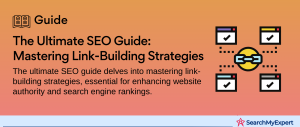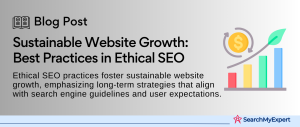Unveiling the Power of Data in Search Engine Optimization
Define SEO Analytics and its Significance in the Realm of Search Engine Optimization
In the constantly evolving digital landscape, SEO Analytics stands as a cornerstone, a powerful tool that turns raw data into actionable insights. At its core, SEO analytics involves the meticulous collection, measurement, and analysis of web data to understand and enhance a website’s performance in search engine results.
Why is it so crucial? Well, imagine navigating a ship in the vast ocean without a compass or map. That’s the challenge of digital marketing without SEO analytics. This process equips marketers and website owners with a deep understanding of how their site is performing, how users interact with it, and where improvements can be made.
The significance of SEO analytics in the realm of search engine optimization is multifaceted:
- Enhanced Visibility: It helps in identifying which keywords and phrases are most effective in drawing traffic.
- User Experience Optimization:
By understanding user behavior, websites can be optimized for better engagement and retention. - Competitive Edge: It provides insights into competitors’ strategies, allowing for more informed decisions.
- ROI Measurement:
It helps in quantifying the effectiveness of SEO strategies, ensuring resources are well-invested.
Highlight the Role of SEO Reporting in Communicating SEO Performance and Driving Strategic Decision-Making
SEO reporting is not just about numbers and charts; it’s a storytelling tool that communicates the narrative of a website’s SEO journey. It’s about turning data into understandable, actionable information that can drive strategic decision-making.
Key Aspects of SEO Reporting:
- Performance Tracking: Reports provide a snapshot of how various SEO tactics are performing, from keyword rankings to traffic growth.
- Identifying Trends and Patterns:
Over time, SEO reports reveal trends that can inform future strategies. - Stakeholder Communication:
They serve as a communication bridge between SEO teams and stakeholders, translating technical aspects into business impacts. - Informed Decision Making: By presenting clear data, SEO reports guide decision-makers in allocating resources and adjusting strategies for better outcomes.
Understanding SEO Key Performance Indicators (KPIs)
Concept of SEO KPIs and Their Role in Measuring SEO Effectiveness
In the intricate world of Search Engine Optimization (SEO), Key Performance Indicators (KPIs) serve as the vital signs of a website’s health and success. SEO KPIs are quantifiable measures that provide insights into how effectively a website is achieving its key business objectives.
Why focus on SEO KPIs? They are the compass that guides digital marketers and SEO professionals, helping them understand if their strategies are on the right path or if adjustments are needed. By closely monitoring these metrics, businesses can make data-driven decisions to optimize their online presence and improve their ranking on search engine results pages (SERPs).
Identify and Discuss Essential SEO KPIs
Several KPIs are crucial in assessing the effectiveness of SEO strategies. Let’s dive into a few key ones:
- Organic Traffic:
This is the number of visitors coming to your site via search engines. It’s a primary indicator of SEO success, reflecting how well your site attracts visitors. - Keyword Rankings: Where your site ranks for important keywords. High rankings usually correlate with increased organic traffic.
- Conversion Rates: This measures the percentage of visitors who take the desired action on your site, whether it’s making a purchase, signing up for a newsletter, or filling out a contact form.
- Bounce Rate: The percentage of visitors who leave your site after viewing only one page. A high bounce rate can indicate that your content is not meeting users’ expectations.
- Page Load Time:
Site speed impacts user experience and SEO. Faster sites tend to rank higher and retain visitors better. - Backlink Profile:
The quality and quantity of backlinks pointing to your website. Strong backlinks from reputable sites boost your site’s authority and rankings.
Explain the Interrelationships Between Different SEO KPIs and Their Collective Impact on SEO Success
The synergy between different SEO KPIs is pivotal. For instance, improved keyword rankings can lead to increased organic traffic. In turn, if the site offers a great user experience, this can reduce the bounce rate and improve conversion rates. Likewise, a robust backlink profile not only enhances site authority but also contributes to better keyword rankings.
Understanding these interrelationships is key to developing a comprehensive SEO strategy that addresses multiple aspects of website performance. By focusing on the right combination of KPIs, businesses can create a cohesive approach to SEO that maximizes visibility, engagement, and conversions.
Data Collection and Tracking Tools for SEO Analytics
In the realm of SEO, data is the lifeblood of decision-making. Collecting accurate and relevant data is crucial, and for this, a variety of tools and sources are employed. Let’s explore some of these essential tools:
- Website Analytics Platforms:
Tools like Google Analytics provide comprehensive data about website traffic, user behavior, and engagement metrics. - Search Engine Consoles:
Google Search Console and Bing Webmaster Tools offer insights directly from search engines, such as search query data, site impressions, and click-through rates. - Specialized SEO Tools: Platforms like SEMrush, Ahrefs, and Moz offer a suite of tools for keyword research, backlink analysis, and competitor insights.
Each of these tools contributes a unique piece to the SEO puzzle, helping to build a complete picture of a website’s search engine performance.
Discuss the Advantages and Limitations of Different Data Collection Methods
Advantages:
- Comprehensive Insights:
These tools offer a wide range of data, from user demographics to search engine rankings. - Real-Time Data:
Many tools provide real-time analytics, allowing for timely adjustments in SEO strategies. - Competitive Analysis:
Specialized tools enable businesses to monitor competitors’ strategies and performance.
Limitations:
- Data Overload:
The sheer volume of data can be overwhelming, making it challenging to identify actionable insights. - Learning Curve: Each tool has its specific functionalities and interfaces, requiring time to learn and master.
- Cost:
Some of the more advanced tools can be expensive, particularly for small businesses.
Emphasize the Importance of Data Accuracy and Consistency for Reliable SEO Analysis
The foundation of effective SEO analysis lies in the accuracy and consistency of data. Inaccurate data can lead to misguided strategies, while inconsistent data collection can skew analysis over time. It is vital to regularly audit and calibrate tools to ensure data integrity. Consistent methodologies in data collection and analysis ensure that the insights derived are reliable and actionable.
Data Analysis and Visualization for SEO Insights
Techniques for Analyzing SEO Data
In the world of SEO, data analysis is the process of turning data into insights. It involves various techniques, each serving a specific purpose in unraveling the story behind the numbers. Key techniques include:
- Data Aggregation:
This involves collecting data from multiple sources and compiling it into a single, comprehensive dataset for analysis. - Segmentation:
This technique breaks down data into specific groups (like demographics, device types, or geographic locations) for more targeted analysis. - Trend Analysis:
By examining data over time, trend analysis identifies patterns and changes in SEO performance, helping predict future trends.
These techniques enable SEO professionals to dig deeper into the data, uncovering the nuances of how different variables interact and impact overall website performance.
Discuss the Role of Data Visualization in Presenting SEO Insights
Data visualization plays a crucial role in SEO. It’s about transforming complex data sets into clear, understandable visuals. Here’s why it’s important:
- Clarity and Comprehension:
Visuals like graphs, charts, and heat maps make it easier to understand complex data. - Quick Insight Generation:
Visual representations allow stakeholders to quickly grasp the essence of the data without getting lost in the numbers. - Effective Communication: They enable SEO professionals to communicate their findings effectively to team members and stakeholders who may not be as data-savvy.
Good data visualization turns abstract numbers into a compelling story, making the insights gleaned from SEO data more accessible and actionable.
Highlight the Importance of Selecting Appropriate Data Visualization Techniques for Different Types of SEO Data
Choosing the right visualization technique is crucial, as it can greatly impact the interpretation and understanding of the data. For instance, line charts are excellent for showing trends over time, bar graphs can compare different data sets, and pie charts are useful for showing composition.
The key is to match the visualization technique with the nature of the data and the insights you want to convey. This thoughtful selection ensures that the visualizations are not only engaging but also accurate and meaningful in conveying the right message.
Crafting Effective SEO Reports
Purpose and Structure of Effective SEO Reports
An effective SEO report is like a map that guides stakeholders through the landscape of a website’s SEO performance. Its primary purpose is to succinctly communicate the results of SEO efforts, identify areas of improvement, and guide future strategies.
Structure of an Effective SEO Report:
- Introduction:
Sets the stage for what the report will cover. - Methodology:
Briefly describes how the data was collected and analyzed. - Performance Overview:
Presents the key findings and data. - Detailed Analysis:
Delves into specific metrics and their implications. - Conclusions and Recommendations:
Summarizes findings and suggests next steps.
This structured approach ensures that the report is both comprehensive and easy to understand, providing a clear picture of SEO performance.
Outline Key Components of SEO Reports
An impactful SEO report consists of several key components:
- Executive Summary: Offers a high-level overview of the report’s main findings.
- Performance Overview: Shows key SEO metrics such as traffic, rankings, and conversions.
- Actionable Recommendations: Provides specific suggestions for improving SEO performance.
- Technical Analysis:
Details any technical issues impacting SEO, like site speed or crawl errors. - Content Analysis: Assesses the performance of different content pieces or types.
- Backlink Profile: Reviews the quality and quantity of backlinks.
Each of these components plays a crucial role in providing a comprehensive view of the website’s SEO performance.
Emphasize the Importance of Tailoring SEO Reports to the Target Audience and Context
The effectiveness of an SEO report greatly depends on its relevance to its audience. A report for a technical team may delve deeper into technical SEO aspects, whereas a report for executives might focus more on performance metrics and ROI. Understanding the audience’s knowledge level and what they value most is key to crafting reports that are not only informative but also engaging and persuasive.
Communicating SEO Insights to Stakeholders
Strategies for Effectively Communicating SEO Insights
Effectively communicating SEO insights to stakeholders is crucial in ensuring that the findings are understood and acted upon. Here are some strategies:
- Understand Your Audience: Tailor the communication style and content based on whether you’re addressing technical teams, management, or clients.
- Simplify Complex Data: Use clear and simple language to explain technical SEO aspects.
- Use Visual Aids: Charts, graphs, and infographics can make complex data more digestible and engaging.
- Focus on Key Metrics: Highlight the most relevant metrics that align with business goals or stakeholder interests.
- Provide Context:
Explain how the data impacts the business or the specific project. - Be Prepared to Answer Questions: Anticipate queries and have in-depth knowledge of the data to provide comprehensive answers.
Importance of Storytelling and Using Data to Support Recommendations
Storytelling in the context of SEO involves weaving data into a narrative that explains the ‘why’ and ‘how’ behind the numbers. It’s about creating a compelling story that illustrates the journey of SEO efforts and their impact. When recommendations are supported by data, they become more persuasive, as they are rooted in concrete evidence rather than just opinion.
Emphasize the Need for Regular Communication and Collaboration to Ensure Alignment with SEO Goals
Regular communication and collaboration are essential in maintaining alignment with SEO goals. Frequent updates and discussions ensure that everyone is on the same page and can pivot quickly if necessary. This ongoing dialogue fosters a deeper understanding of SEO strategies and their outcomes, making it easier to integrate SEO insights into broader marketing and business strategies.
Utilizing SEO Analytics for Continuous Improvement
How SEO Analytics Can Be Used to Identify Areas for Improvement and Optimize SEO Strategies
SEO analytics is not just a tool for measurement, but a compass for continuous improvement. It provides a wealth of data that can be analyzed to identify strengths, weaknesses, and opportunities in SEO strategies. Here’s how it works:
- Identifying Trends:
Analytics help in spotting both positive and negative trends in SEO performance. - Benchmarking Performance:
By comparing current performance with past data, businesses can assess their progress. - Competitor Analysis: SEO analytics tools can reveal competitors’ strategies, providing insights into areas where a business can improve.
- User Behavior Analysis:
Understanding how users interact with a site can highlight areas for improvement in content, site structure, and user experience.
Discuss the Importance of Setting Realistic SEO Goals and Tracking Progress
Setting realistic SEO goals is a critical step in strategy development. These goals should be Specific, Measurable, Achievable, Relevant, and Time-bound (SMART). Once the goals are set, tracking progress is essential. It involves:
- Regularly Reviewing Key Metrics: Keeping an eye on KPIs to measure progress toward the set goals.
- Adjusting Strategies Based on Data: Using insights from analytics to refine SEO strategies.
- Celebrating Milestones: Recognizing achievements to motivate the team and validate strategies.
Realistic goals provide a clear direction for SEO efforts and make it easier to evaluate success.
Emphasize the Need for Ongoing SEO Monitoring and Adaptation
The digital landscape is ever-changing, with new industry trends and algorithm updates constantly emerging. Ongoing SEO monitoring and adaptation are crucial:
- Staying Updated with Algorithm Changes: Search engines frequently update their algorithms, impacting how websites are ranked.
- Responding to Industry Trends:
Keeping up with industry trends helps in staying relevant and competitive. - Continuous Learning and Improvement:
Regular analysis of SEO performance fosters a culture of continuous learning and improvement.
Conclusion
In the intricate and ever-evolving world of digital marketing, SEO analytics emerges as a beacon of insight and direction. From understanding the foundational aspects of SEO KPIs to leveraging advanced tools and techniques for continuous improvement, this article has delved into the multifaceted realm of SEO analytics.
The journey through SEO analytics is not just about data collection and analysis; it’s a strategic endeavor to improve website visibility, user engagement, and ultimately, business success. By effectively crafting and communicating SEO reports, setting realistic goals, and adapting to the dynamic digital landscape, businesses can stay ahead in the competitive online world.
As we’ve seen, the key lies in the meticulous application of SEO analytics to inform decision-making and strategy optimization. Whether you’re a seasoned SEO professional or a business owner seeking to enhance your online presence, the insights and practices outlined in this article provide a roadmap for success in the digital arena.
Remember, the world of SEO is constantly changing, and staying informed, adaptable, and proactive is essential for achieving and maintaining SEO excellence.
Let our SEO Companies catapult your site to the top of search results.
Table of Contents
Toggle






